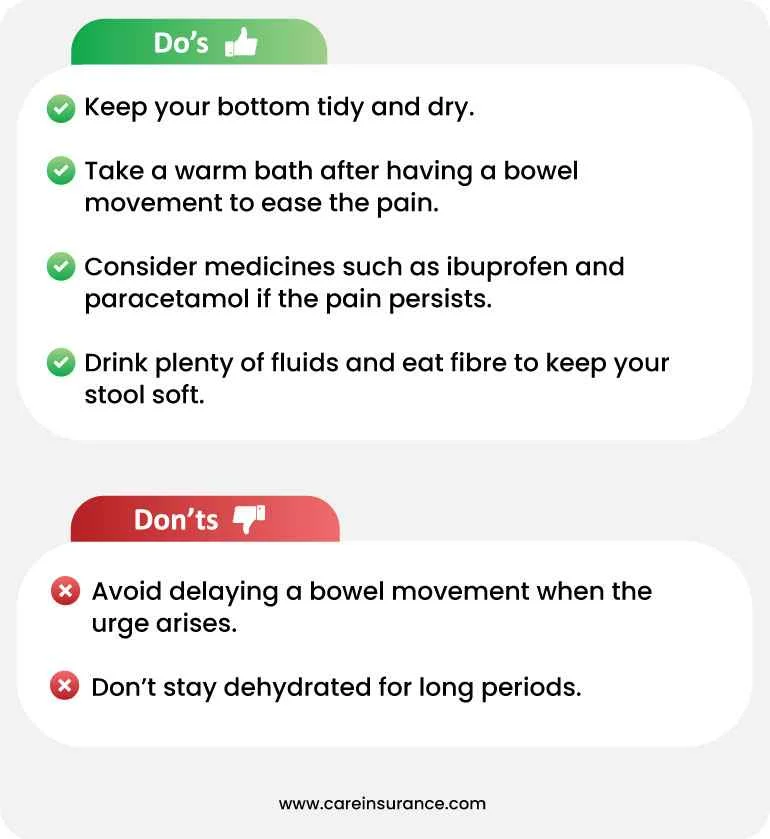Subscribe to get weekly insights
Always stay up to date with our newest articles sent direct to your inbox
Published on 23 Jul, 2025
129 Views
3 min Read

Written by Yashita Sinha
Reviewed by Akhil Pillai
favorite0Like
favoriteBe the First to Like
In our regular lives, we often hear about common illnesses like dengue, malaria, fever, and the common cold. These are the conditions that people openly discuss and seek help for. However, there are other sets of conditions which are rarely discussed, not because they are not important, but because of the stigma attached to them. One such condition is anal fissure- a painful disease that silently affects individuals.
Today, we are going to throw light on this lesser-known issue, aiming to explain its symptoms and provide useful information about all related aspects. Let’s start by knowing about it and understanding why it needs to be discussed openly.
Anal fissure is a persistent condition that tears your anal lining, causing extreme pain and bleeding. Its impact is profoundly felt in daily activities. Simple activities like walking, sitting, and standing become painful. To help you understand better, its symptoms are broken down into simple points below.
Here are some warning signs of anal fissure that you should look out for:
Now that we’ve discussed the symptoms, let’s move on to understand the causes of this condition.
Some of the most common causes of anal fissure are:
Did you notice that the symptoms of piles and fissures are almost similar? This similarity makes it easy to mistake one condition for another. For some clarity, let’s understand the difference between the two.
Since both piles and anal fissure affect the anal region, they’re often thought to be the same. However, they’re two different conditions. Piles cause inflammation of veins in the rectum, whereas fissures are small cracks in the anal lining.
Additionally, piles are visible as lumps around the anal region, causing itching, bleeding, and discomfort. Anal fissure, on the other hand, causes intense pain during and after bowel movements.
Doctors follow a simple process to diagnose an anal fissure. First, they’ll ask about the symptoms that a patient is experiencing. The next step involves physical examination of the fissure. For this purpose, they can follow either of the following procedures:
This procedure involves inserting a tubular device (anoscope) into the anus to examine the
rectum and anus from inside.
In this procedure, doctors insert a flexible tube into the rectum to inspect the entire colon. It is usually done when a patient is at higher risk of colon cancer.
This procedure involves inserting a thin, flexible tube with a camera attached into the lower portion of the colon. It's done for individuals who don’t show any risk factors for intestinal diseases or colon cancer.
>> Also Read: Diseases Covered under Health Insurance Policy
Medical treatment for anal fissure is focused towards relaxing the anal sphincter muscles surrounding your anal canal. This allows the fissure to close gradually, helping to restore blood flow to the tissues. There are three ways in which they can be treated.
If you notice the symptoms of anal fissure, there are certain dos and don’ts that you need to keep in mind:

Anal Fissure is one of the most painful conditions to live with. It can be physically and mentally draining. The intense pain during bowel movements can make everyday activities like walking, sitting, or even standing feel like a challenge.
Now that you’re aware of the symptoms and causes of the condition, you can follow the steps mentioned in the do’s section to prevent it. With simple lifestyle changes, it is possible to reduce the risk of developing the condition. However, there’s no guarantee that these measures will be completely helpful in keeping it at bay. In such cases, timely action is crucial.
This is where having comprehensive health insurance plans in India can do wonders. It not only eases the financial burden of consultations, medicines and surgery if required, but also ensures that you get access to quality treatments without any delay.
Disclaimer: The above information is for reference purposes only. Kindly consult your general physician for verified medical advice. The health insurance benefits are subject to policy terms and conditions. Refer to your policy documents for more information.
favoriteBe the First to Like
Thyroid : मामूली नहीं हैं महिलाओं में थायराइड होना, जानें इसके लक्षण और घरेलू उपचार Vipul Tiwary in Diseases
शुगर कंट्रोल कैसे करे? जानें, डायबिटीज में क्या खाना चाहिए Vipul Tiwary in Health & Wellness
हाई ब्लड प्रेशर को तुरंत कंट्रोल कैसे करें? देखें इसके उपाय Vipul Tiwary in Diseases
पैरों में दर्द किस कमी से होता है? जानें, इसके घरेलू इलाज Vipul Tiwary in Health Insurance Articles
Health Benefits of Brahmi: A Complete Guide to This Ancient Ayurvedic Herb Pratham Gupta in Health & Wellness
Is Your Phone Stealing Your Sleep? Master Simple Strategies for Screen Time Mudit Handa in Health Insurance Articles
Basti Karma: The Ayurvedic Secret to Balancing Vata Dosha Mudit Handa in Health & Wellness
Parents Alert: Early Symptoms of Calcium Deficiency in Kids Jagriti Chakraborty in Child Care
Drinking plenty of fluids, eating a high fibre diet and using topical creams can speed up healing. In some cases, warm baths and prescribed medicines might also provide relief.
Reduced pain in bowel movements and less bleeding are some signs that a fissure is healing.
While there’s no restriction on drinking milk in fissures, some individuals might experience constipation due to high-fat dairy products like milk.
Anorelief Cream is recommended for fissures. It relieves the pain, swelling and discomfort experienced while passing stools.
Always stay up to date with our newest articles sent direct to your inbox
Loading...